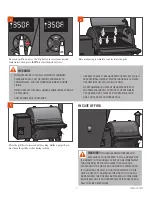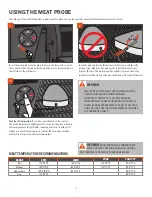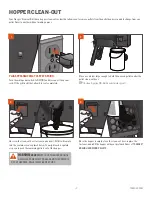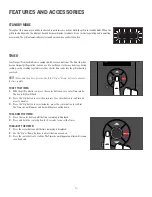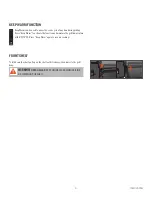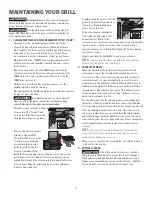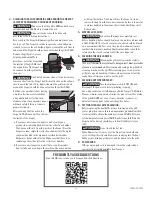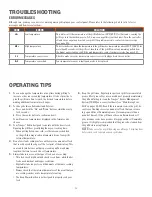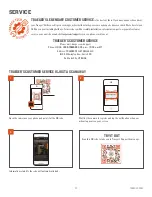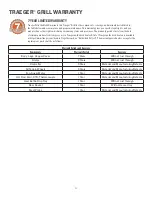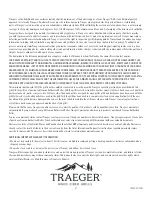
23
TRAEGER.COM
4.
CLEANING THE ASH FROM INSIDE AND AROUND THE FIREPOT
(AFTER APPROXIMATELY 30 HOURS OF COOKING):
w
WARNING
Make sure that the grill is COLD and ashes are
extinguished and COLD before cleaning the ash.
w
WARNING
Disposal of ashes should be done only
according to the following instructions.
Excess ash in the firepot will hamper ignition and may cause your
fire to go out. The firepot should be inspected occasionally and
cleaned to remove the ash buildup. Again, cleaning the ash from in
and around the firepot should be done only when the grill is COLD.
Remove the grill grates, grease
drip tray, and heat baffle to
provide access to the firepot and
the interior of the grill. Much of
the ash outside of the firepot can
be removed from the grill with a
shop vac.
w
WARNING
A dedicated vacuum cleaner is the best way to
remove ashes from the firepot, but this must be done with extreme
care to avoid the risk of fire. Again, cleaning the ash from in and
around the firepot should be done only when the grill is COLD.
A utility-type vacuum cleaner having
a metal collection canister without
a bag would be best for this task.
However, almost any vacuum cleaner
will work safely if this procedure is
properly followed.
After ensuring that the ash in the
firepot is COLD, vacuum the ash from
the inside of the firepot.
a.
If your vacuum cleaner is a bagless model, empty any
previously accumulated debris from the collection chamber.
Then vacuum the ash from the inside of the firepot. Once the
firepot is clean, empty the collection chamber into the metal
container handled in the manner
described below under
Disposal of Ashes without delay. Make sure that there is no
remaining ash residue left in the collection chamber.
b.
If your vacuum cleaner is a model that uses a disposable
bag, install an unused bag in the machine. Then vacuum the
ash from the inside of the firepot. Once the firepot is clean,
remove the bag from the vacuum cleaner and place it in a metal
container handled in the manner described under Disposal of
Ashes below.
5.
DISPOSAL OF ASHES:
w
WARNING
Ashes should always be completely cool
before handling. Ashes should be placed in a metal container with
a tight-fitting lid. The closed container of ashes should be placed
on a noncombustible floor or on the ground, well away from all
combustible materials, pending final disposal. Ashes should be
retained in the closed container until they are disposed.
6.
CLEANING THE GRILL GRATES:
w
WARNING
Cleaning the grill grates works best while
they are still warm.
Be careful not to burn yourself. Heat-protective
gloves are recommended.
We recommend keeping a long-handled
cleaning brush near the grill. After removing your food, give the
grill grate a quick brushing. It takes only a minute and it will be
ready the next time you want to use the grill.
7.
CLEANING OUTSIDE SURFACES:
w
WARNING
Turn the main power switch OFF (
O
) and
disconnect the power cord before initiating cleaning.
Use a disposable rag or cloth dampened with Traeger® All Natural
Cleaner or warm, soapy water
to wipe the grease from the outside
of the grill. DO NOT use oven cleaner, abrasive cleansers, or
abrasive cleaning pads on the outside grill surfaces.
8.
TESTING THE GRILL AFTER CLEANING:
Before replacing the heat baffle, grease drip tray, and the grill
grates, plug the power cord into an appropriate grounded/earthed
electrical outlet and turn the main power switch ON (
I
). After you
set the temperature and press IGNITE, pellets should fall into the
firepot and the hot rod should begin to heat (it will start to turn
red).
w
WARNING
Do not touch the hot rod.
When flames start to come out of the firepot, run the shutdown
cycle. Let the grill cool down. Now you’re ready to place the heat
baffle, grease drip tray, grill grates, and food back onto the grill.
9.
POWER CORD
If the power supply cord is damaged, it must be replaced by a
special cord assembly available from Traeger.
FREQUENTLY ASKED QUESTIONS
Scan this QR code to take you to Frequently Asked Questions.









